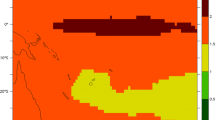Summary
Tropical Cyclone Drena, a relatively long lived cyclone lasting from January 2, 1997 to January 10, 1997, crossed over three well separated island groups and affected a fourth in the south western Pacific Ocean during different stages of its life cycle. Midway through its transition into an extra-tropical low, it passed over the eastern edge of Norfolk Island, an isolated island located in the western Pacific Ocean midway between New Zealand and New Caledonia, at 0615 UTC (1745 local) on January 9, 1997. The tropical cyclone exhibited markedly different characteristics during each phase of its life cycle, with thick fog being reported during the eye passage at Norfolk Island. Although routine global and Australian region numerical models were able to provide the operational forecasters with broad scale guidance as to the movement of the tropical cyclone, the level of detail available at these resolutions is insufficient to identify the characteristics important to communities in the tropical cyclone's path. The high resolution numerical model (HIRES) developed by the University of New South Wales, was run at a resolution of 25 kilometres to investigate the evolution of the tropical cyclone from a warm cored, quasi-symmetrical vortex into a highly asymmetrical mid latitude low pressure system. The model captures the observed wind and precipitation structure of the cyclone very well during this crucial transition phase. The comparison extends into the vertical with a model derived vertical cross section depicting the key features observed in a sequence of ten specially requested radiosonde flights, released at six hourly intervals, from Norfolk Island which transect the passage of the tropical cyclone over this remote island.
Similar content being viewed by others
References
Bourke, W., Hart, T., Steinle, P., Embery, G., Naughton, M., Rikus, L., 1995: Evolution of the Bureau of Meteorology's global assimilation and prediction system. Part 2. Resolution enhancements and case studies.Aust. Meteor. Mag.,44, 19–40.
Bureau of Meteorology, Queensland Tropical Cyclone Warning Centre, 1997. Best track and central pressure analysis for Tropical Cyclone Drena (personal communication).
DiMego, G. J., Bosart, L. F., 1982a: The transformation of Tropical Storm Agnes into an extra-tropical cyclone. Part I. The observed fields and vertical motion computations.Mon. Wea. Rev.,110, 385–411.
DiMego, G. J., Bosart, L. F., 1982b: The transformation of Tropical Storm Agnes into an extra-tropical cyclone. Part II. Moisture, vorticity and kinetic energy budgets.Mon. Wea. Rev.,110, 412–433.
Dvorak, V. F., 1984: Tropical cyclone intensity analysis using satellite data.NOAA Tech. Rep. NESDIS 11, 47 pp.
Foley, G. R., Hanstrum, B. H., 1994: The capture of tropical cyclones by cold fronts off the west coast of Australia.Weather and Forecasting,9, (4), 577–592.
Holland, G. J., 1984a: On the climatology and structure of tropical cyclones in the Australian/southwest Pacific region. I: Data and tropical storms.Aust. Meteor. Mag.,32, 1–16.
Holland, G. J., 1984b: On the climatology and structure of tropical cyclones in the Australian/southwest Pacific region. II: Hurricanes.Aust. Meteor. Mag.,32, 17–32.
Holland, M. J., 1984c: On the climatology and structure of tropical cyclones in the Australian/southwest Pacific region. III: Major hurricanes.Aust. Meteor. Mag.,32, 33–46.
Leslie, L. M., LeMarshall, J. L., 1977: The generation and assimilation of cloud drift winds in numerical weather prediction.J. Meteor. Soc. Japan,75, 1–11.
Leslie, L. M., Skinner, T. C. L., 1994: Real-time forecasting of the Western Australian summertime trough: Evaluation of a new regional model.Weather and Forecasting,9, 371–383.
Sinclair, M. R., 1993: Synoptic-scale diagnosis of the extratropical transition of a southwest Pacific tropical cyclone.Mon. Wea. Rev.,121, 941–960.
Skinner, W., 1995: Numerical prediction model performance summary April–June 1995.Aust. Meteor. Mag.,44, 309–312.
Skinner, W., Hart, T., 1997: Numerical prediction model performance summary July–September 1996.Aust. Meteor. Mag.,46, 51–55.
Author information
Authors and Affiliations
Additional information
With 10 Figures
Rights and permissions
About this article
Cite this article
Buckley, B.W., Leslie, L.M. High resolution numerical simulation of Tropical Cyclone Drena undergoing extra-tropical transition. Meteorl. Atmos. Phys. 65, 207–222 (1998). https://doi.org/10.1007/BF01030789
Received:
Revised:
Issue Date:
DOI: https://doi.org/10.1007/BF01030789




